Our 2021 survey finds pervasive heavy meth use and quantifies its damaging effects on people struggling with the substance, as well as their risks before, during and after treatment.
Methamphetamine is a highly addictive stimulant that creates feelings of pleasure and energy while seriously damaging the body, sometimes fatally. Even one dose of methamphetamine, also called meth, can lead to an addiction or a life-threatening overdose.
Despite the risks, more than2 million Americansover the age of 12 used meth in 2019, with an average of510 new meth usersevery day. People are also taking more meth more often: the number of overdose deaths from psychostimulants (primarily meth) has risen quickly to16,167deaths in 2019, more than eight times the 2012 count.
The Recovery Village regularly conducts substance use and mental healthresearchto inform and support rehabilitation and behavioral health awareness efforts. We recently surveyed more than two thousand current and former meth users to better understand their meth use, detox, and recovery experiences. Recognizing the incredible risks meth use places on a person’s life and how treatment can save lives can help our communities turn the tide against meth addiction.
The Recovery Village Meth Survey Results
Our study surveyed 2,135 American adults who formerly or currently use methamphetamine. We asked them about their meth use, reasons for using, meth-related outcomes, health and more. In addition, 1,784 respondents had undergone adetox from methand were asked about their detox experiences and how their recovery was going. Of these, 1,126 respondents were asked about their experiences at a rehabilitation treatment facility. Note: Some questions asked respondents to select each option that applied, so the total percentage will be greater than one hundred in a few instances.
Treatment Can Be Life Changing. Reach out today.
Whether you are struggling with addiction, mental health or both, our expert team is here to guide you every step of the way. Don’t wait— reach out today to take the first step toward taking control of your life.
Methamphetamine Use Stats
While any methamphetamine use is considered misuse and can lead to an addiction, many people addicted to meth are significantly increasing their risk of dependence, withdrawal and overdose by using frequently and in high amounts.When asked about their meth use:
- 67% of participants used meth several times per week or more
- 23% never let themselves get off meth, using multiple times per day, every day
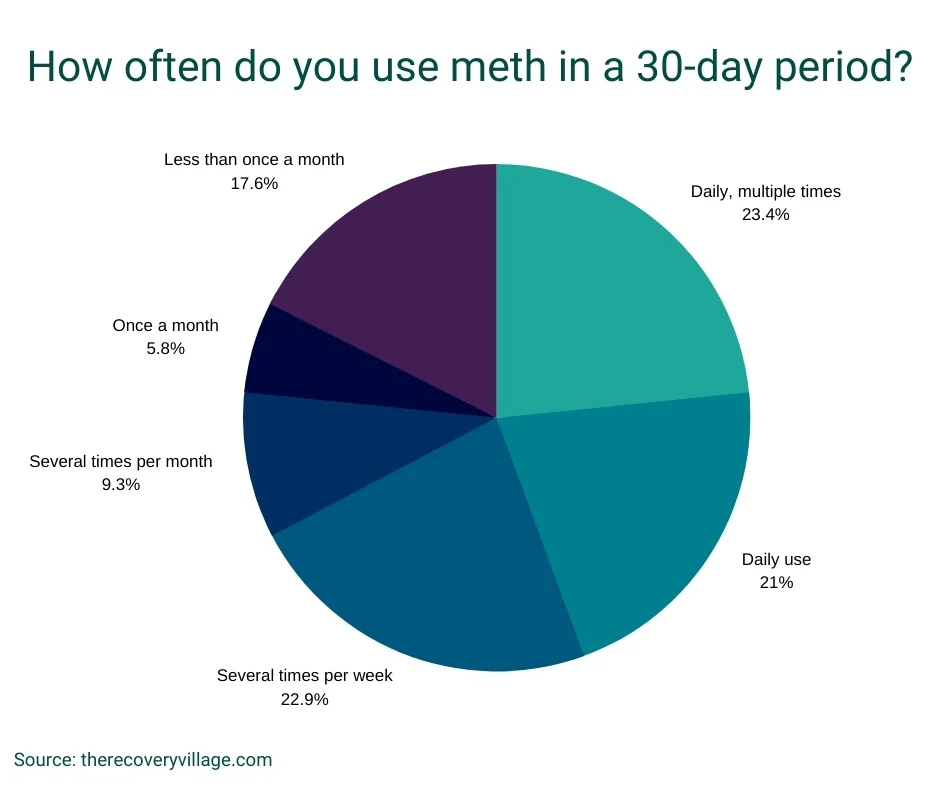
On average, police reports label0.2 grams of methas an average dose, which would keep the average person high for approximately seven hours. Based on this measurement:
- Almost 60% of respondents took 1-2 doses of meth in a 24-hour period, which generally covered their time awake.
- However, 41% of respondents used more than 0.5 grams, with 9% using over an entire gram of meth in 24 hours.
Considering frequency and quantity together,73% of respondents qualified as “heavy meth users,”putting them at substantially greater risk for addiction, overdose, negative health impacts and death.
Lifetime Use
Even one dose of meth can set off a chain reaction towards addiction. However, the longer you use meth, the more likely you are to overdose and experience negative side effects on your health, relationships and lifestyle. In our study:
- 4 out of 5 participants (83%) had used meth for more than 30 days in their lifetime. Only 17% stopped before that point.
- 43% of participants had used meth for more than a year, and 13% had used meth for more than five years.
Method of Use
People consume meth in four primary ways, including smoking it through a pipe, snorting the crystals, injecting a liquid solution intravenously, or swallowing a pill form, often called “speed.” Each of these methods has added health risks, and some people use multiple methods to get their high.
Smoking meth is the most common method (63%), followed by snorting (44%), injecting (27%) and swallowing (30%). While more than half of people stick to one method of using meth (59%), 41% use multiple methods and 7% use all four methods over their lifetime.
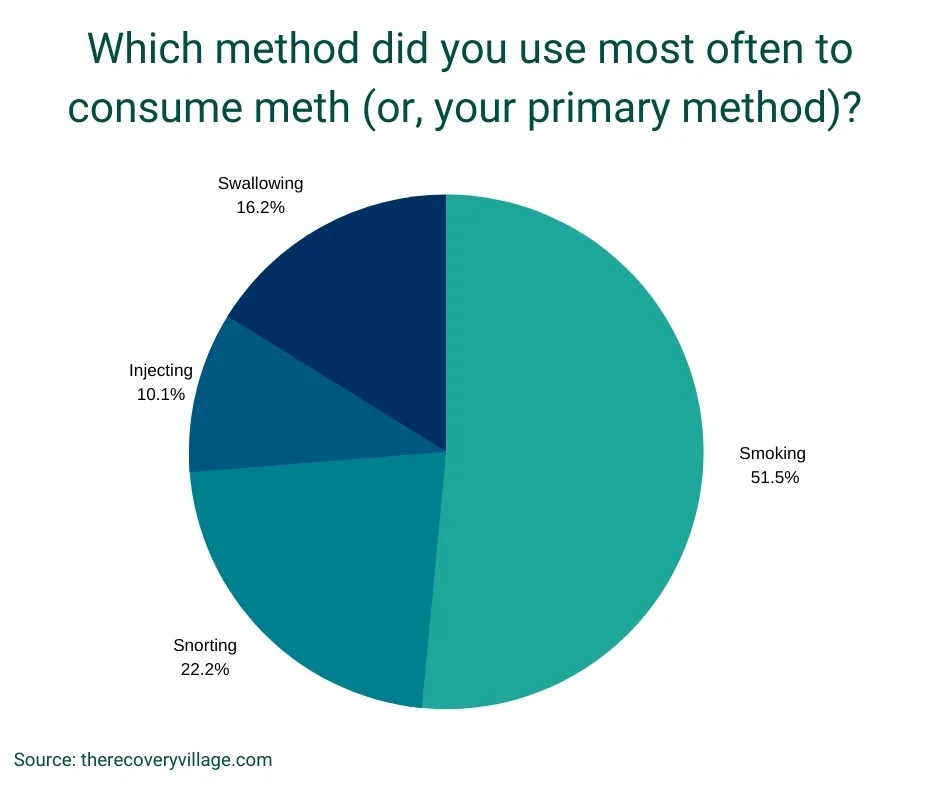
Reasons for Using Meth
Meth is a stimulant that releases large amounts of the neurotransmitter dopamine in the brain. People start using meth for a variety of reasons, often related to the pleasurable feelings or energy they get from it.
Repeated meth use usually creates a tolerance for the substance, requiring greater and more frequent doses to get the same effect. Dependence may then develop, where the person cannot stop taking meth without experiencing withdrawal symptoms. Participants who qualified as heavy meth users wereseven times more likelyto admit they were physically dependent on meth.
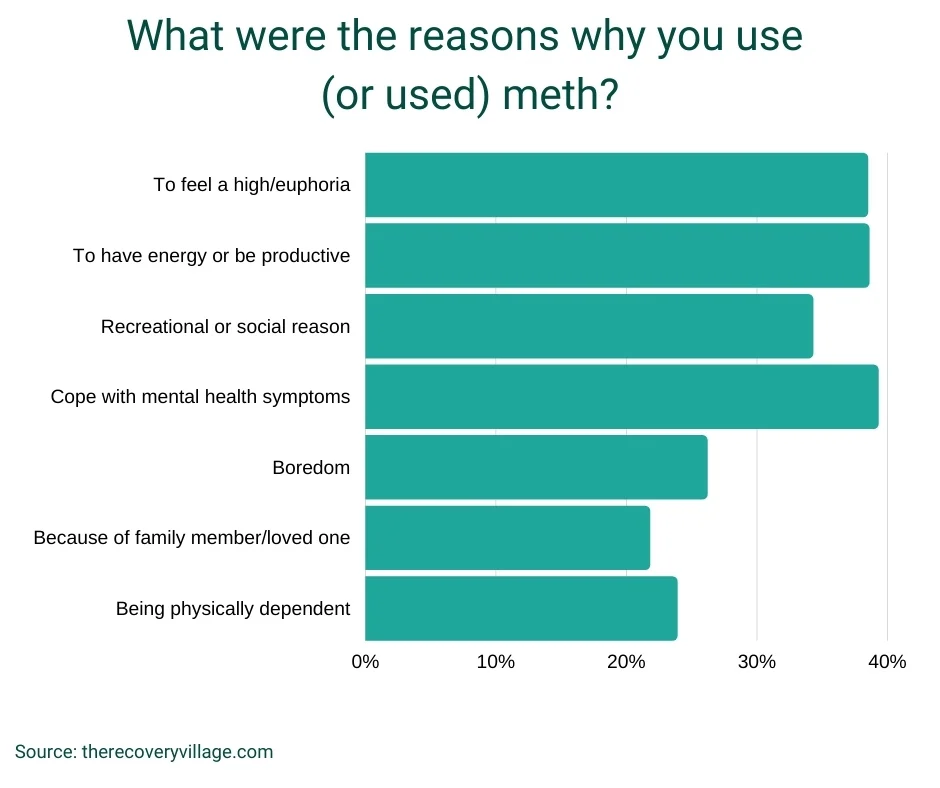
Methamphetamine and Your Life
Once you’ve gained a meth addiction, it can wreak havoc on your health, relationships and interests. In particular,parents and professionals were at greater riskas heavy users: being a heavy meth user tripled your chances of struggling as a parent and doubled the chance meth would impact your job. It also doubled your risk of having meth affect your appearance.
When asked to rank these impacts, participants agreed: meth has the biggest impact on your mental health, followed by your physical health, relationships and finances.

Methamphetamine and Your Health
A vast majority of participants (93%) experienced several health issues directly related to their meth use, impacting their physical appearance, bodily systems and mental state. In many cases, these complications were life-threatening.
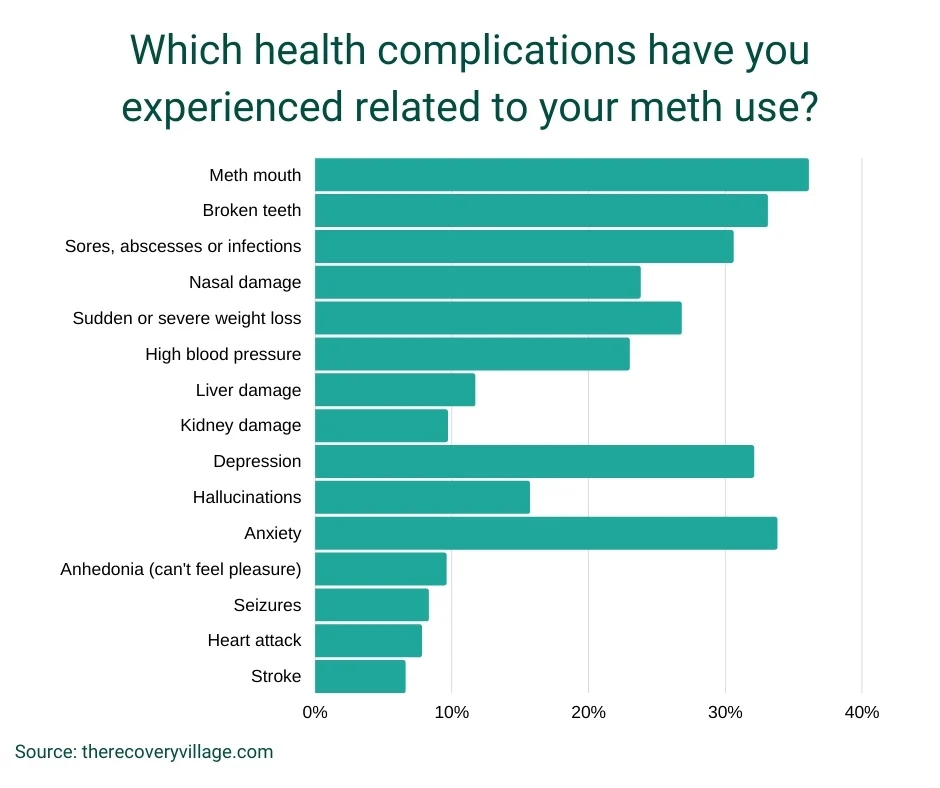
Doubling, tripling or quadrupling your risk for these health issues is possible. Using meth just six times a month or more than 0.4 grams in a session can easily make these symptoms a reality. Heavy meth use increases a person’s risk for all methamphetamine-related health issues. In particular, heavy meth users are:
- 4.4 times more likely to have meth mouth
- 3 times more likely to have broken teeth
- 2.3 times more likely to have a sore or infection
- 3.2 times more likely to damage your liver
- 2 times more likely to damage your kidneys
- 2.9 times more likely to have a stroke
- 2.6 times more likely to have a heart attack
- 2.4 times more likely to have a seizure
- 2.5 times more likely to lose your ability to feel pleasure
Medical Emergencies
Meth is one of the top illicit drugs involved inemergency room visitsand overdose deaths. Many of these deaths involved not receiving medical care in time. Even if you manage to avoid a life-threatening emergency, meth use can still damage the body, often requiring medical care at a hospital, primary care doctor or dentist. Among those surveyed, 68% required medical care because of meth:
- 1 in 3 (37%)had an emergency hospital visit (such as for an overdose)
- 1 in 5 (21%)overdosed without getting medical care
- 1 in 3 (38%)had to visit the doctor or dentist because of meth use
Heavy meth use (either in frequency or amount) severely increases your risk for these impacts. Heavy meth users were:
- 5x more likelyto have an emergency hospital visit
- 3x more likelyto overdose without any medical care
- 2x more likelyto require doctor or dentist visits
It’s important to remember this study only surveyed those in recovery from meth use or who were currently using meth. We’re only able to question those who experienced either a close call or non-lethal impacts. Those who have died from meth use could not take this survey and their experiences don’t factor into the results.
Finding Help for a Meth Addiction
If you or a loved one is struggling with meth use, there are a multitude of resources available. Roughly 3 in 4 people using meth (73%) seek outside help for their substance use. Heavy meth users are more likely to choose rehab over other treatment options: 51% of heavy meth users choose rehab, compared to 36% of all participants.
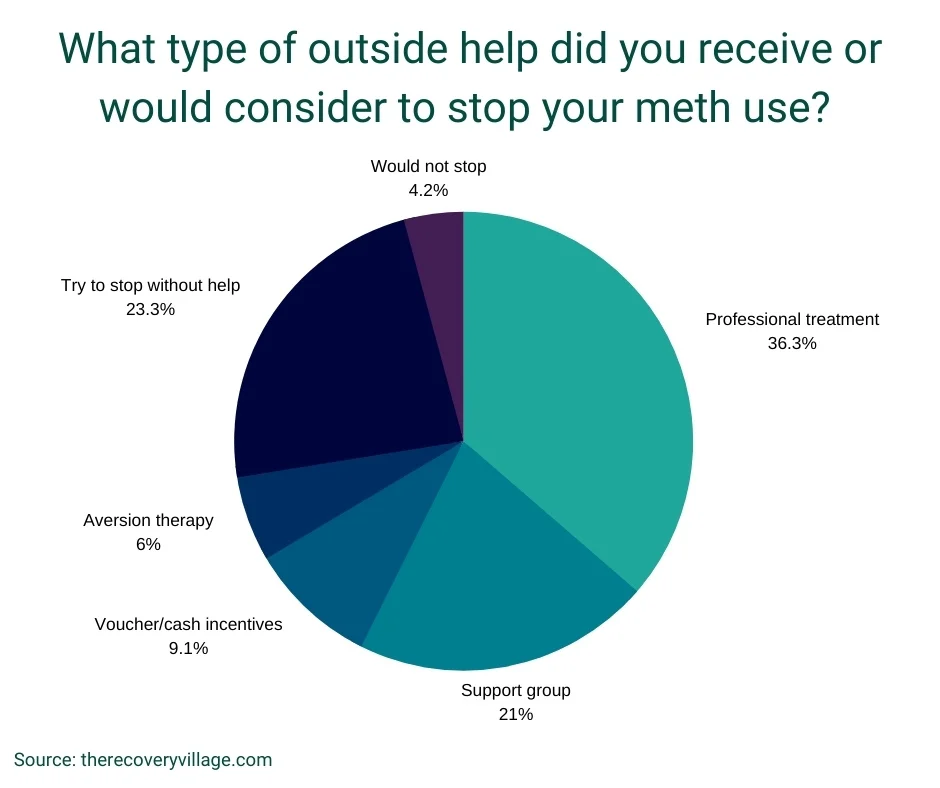
Among those surveyed, 61% of people who completed internet searches to find help ended up choosing a rehab facility over other options. In fact, they were more than twice as likely as their peers to do so. If you’re relying on internet searches to find potential treatment centers,ask these questionsto find a licensed facility that can meet your needs.
Deciding What’s Right for You
When deciding where to get help for a meth addiction, many factors can affect your decision, including:
- Availabletreatment programs
- Professional credentials/accreditations
- Length of program
- Accommodations/amenities
- Location
- Success rates
- Convenience
- Cost
- Wait time to enter care
When asked to rank the factors that may have influenced their decision, the cost was the most important factor on average, followed by the specific treatment programs offered and the facility’ssuccess rates. Thankfully,health insuranceoften covers many rehab treatments and services. Many facilities, including The Recovery Village, can work with you to make treatment more affordableif you don’t have insurance.
Meth Detox & Withdrawal
Detoxificationis the first step towards recovery from meth, in which the body rids itself of all the methamphetamine in its system. People dependent on meth will experience uncomfortablewithdrawal symptomsthat can make it challenging to quit meth. Some meth withdrawal symptoms are dangerous, so detoxingunder medical supervisionis the safest way to enter recovery.
Of all participants who reported detoxing from meth at some point in their lives, 2 out of 3 decided to detox at home (66%), while 34% decided to detox at a rehab center or medical facility.
While the majority of participants were only detoxing from meth, 23% were detoxing from multiple substances. Polysubstance use can complicate the detox process, increase or intensify withdrawal symptoms. In fact, people detoxing from only meth were 2.7 times more likely to finish their treatment than those detoxing from multiple substances. Detoxing from polysubstance use is possible but should be done under medical supervision to make the process as safe and successful as possible.
Meth Withdrawal Symptoms
Methamphetamine withdrawal is a physiological and psychological experience. Overall, respondents who had detoxed from meth reported the following withdrawal symptoms:
- 2 in 3 participants reported headaches (63%)
- 1 in 2 participants reported fatigue (57%)
- 1 in 2 participants reported sleep problems (52%)
- 1 in 3 participants reported appetite issues (36%)
- 1 in 4 participants reported high body temperature (24%)
- 2 in 5 participants reported depression (41%)
- 2 in 5 participants reported anxiety (41%)
- 1 in 5 participants reported paranoia (20%)
- 1 in 4 participants reported aggression (27%)
- 1 in 6 participants reported hallucinations (16%)
- 1 in 10 participants reported anhedonia (11%)
Heavy meth use increases your chances of having any and every withdrawal symptom, but it especially impacts how you experience the world around you, which can be scary. Heavy meth users were:
- 41% more likely to feel paranoid
- 45% more likely to become aggressive
- 47% more likely to have hallucinations
Meth Withdrawal Timeline
Generally, the meth withdrawal timeline has two phases which can vary in length depending on a person’s meth use, physiology and other factors. The first is a “crash” involving a sharp decline in energy and other withdrawal symptoms. While a two-day crash was the most common experience, 95% of all participants experienced their crash within the first ten days.
The second phase is a longer period where the person feels cravings for meth. The vast majority (95%) of all participantsexperienced cravings for up to seven weeks, so most people can expect their cravings will calm down in the first or second month after stopping meth use.
Meth Rehab & Recovery
Among the participants who’d attended substance abuse treatment, most spent their first time ininpatient or residential care(54%). Starting at a higher level of care (like inpatient care) and slowly moving down to less intensive levels of care as you improvehas been shownto have better outcomes for recovery. In fact, people who started rehab with inpatient treatment were 31% more likely to finish their programs than those who didn’t.
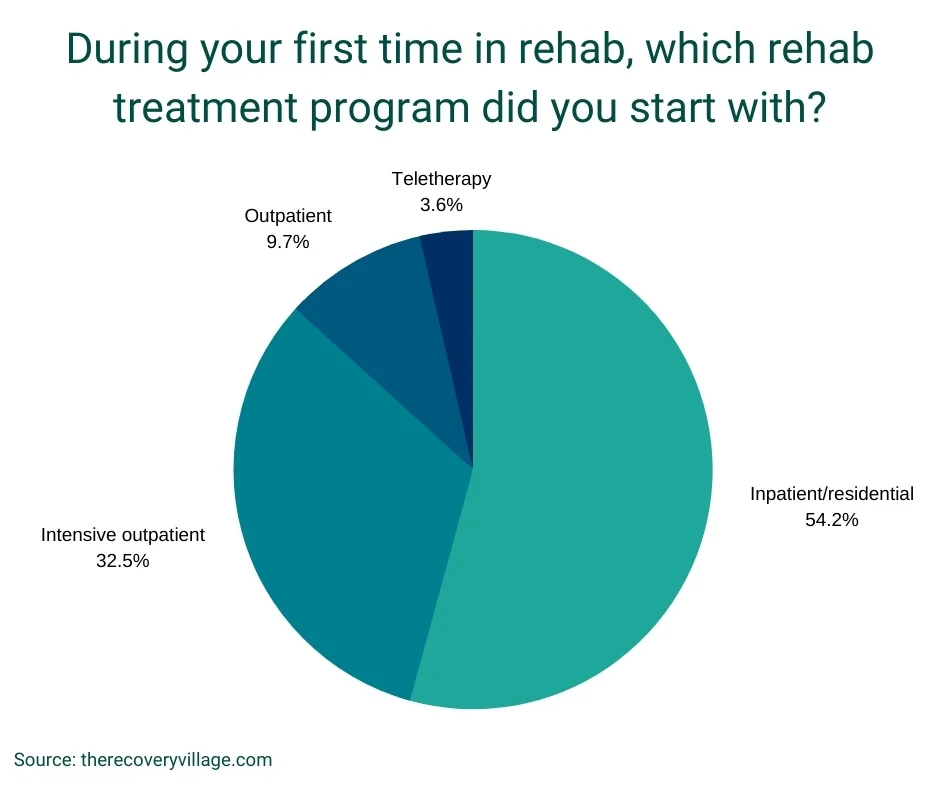
Using meth more heavily increases your chances of needing higher levels of care. Heavy meth users are 22% more likely to need inpatient or residential care than others.
Rehab programs also vary in length. For example, outpatient programs generally last longer than inpatient care but are less intensive. Among those surveyed, 4 out of 5 spent less than two months in rehab (85%).

People entering recovery from methsometimes travelout-of-state to find a rehab program that suits their needs best. People who were detoxing from multiple substances, for example, were 2.5 times more likely to travel out-of-state for their rehab, potentially seeking a facility that could handle the added complications of treating polysubstance use.
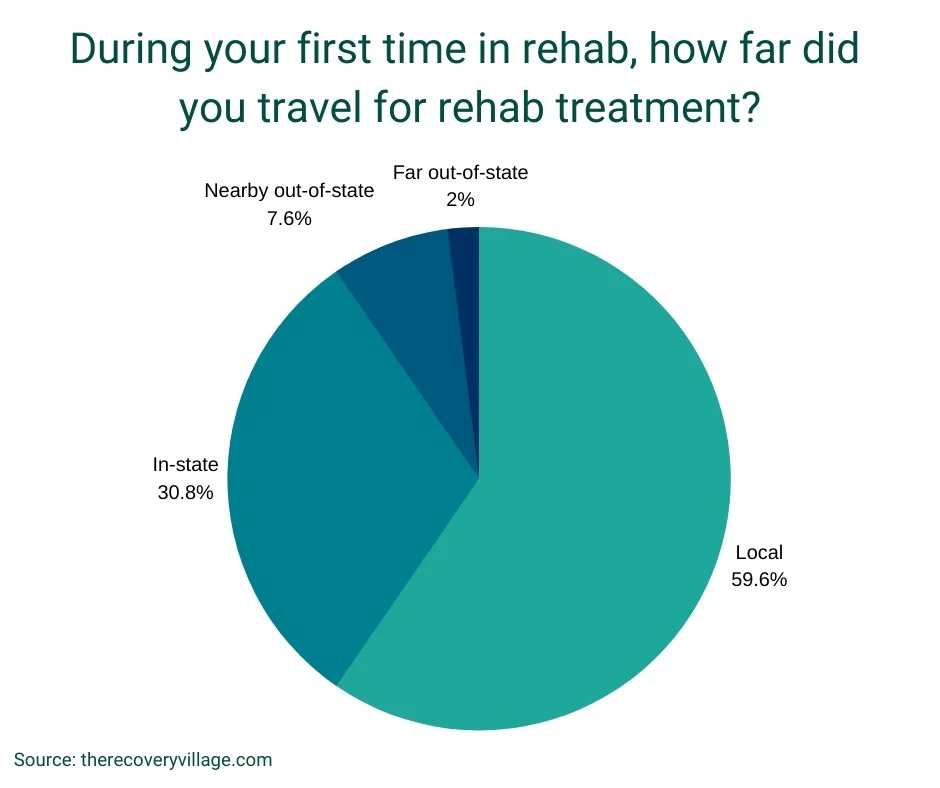
Relapse & Long-Term Recovery
Relapse is a common occurrence during long-term recovery, and it doesn’t mean failure.Four out of five participants reported relapsingafter they started recovery (79%). However, the longer you can maintain your sobriety during recovery, the smaller your chances of relapsing become.
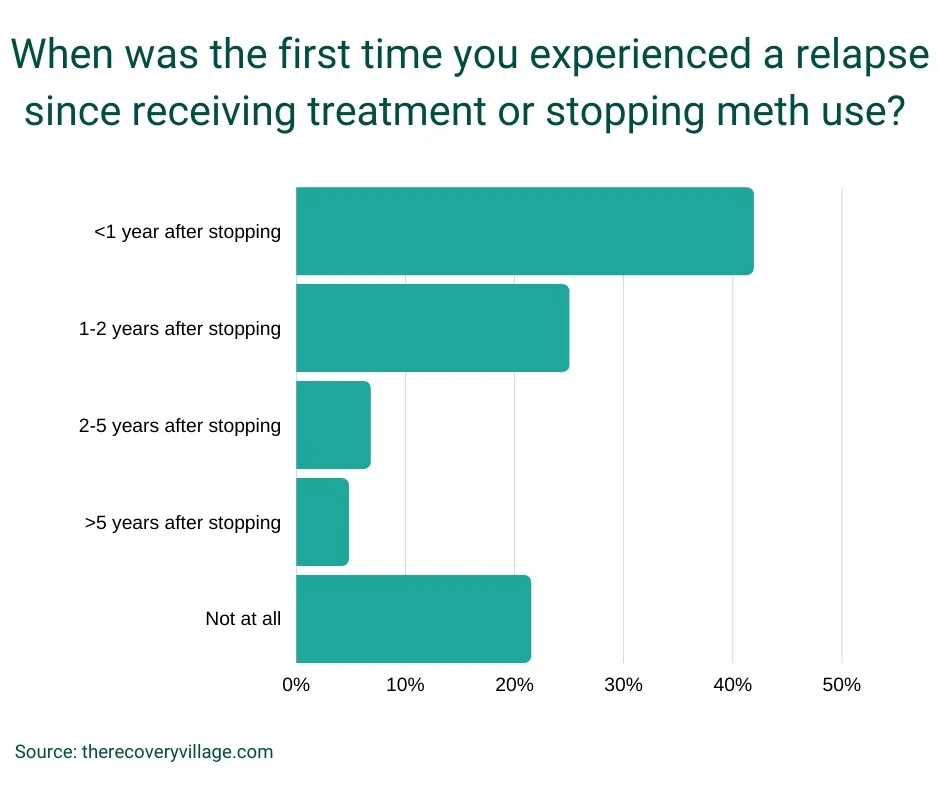
Using meth more heavily makes recovery harder and relapse more likely. Heavy meth users were 6.6 times more likely to relapse than others. Heavy meth users may expect to return to or extend treatment as a recurring part of their lives in recovery.
Recovery is a lifelong experience, and it is not uncommon for people who use methamphetamine to attend rehab treatment more than once over their lifetime. Among those surveyed, 7 out of every 10 people that attended substance abuse treatment did so more than once (73%).
Relapse Prevention
Finishing your treatment program completely increases your chances for good recovery outcomes and lowers your chance of relapse, while leaving early does the opposite, increasing your risk of relapse by 92%. Thankfully, successful completion is a norm in methamphetamine use disorder treatment:84% of respondents reported finishing their treatment.
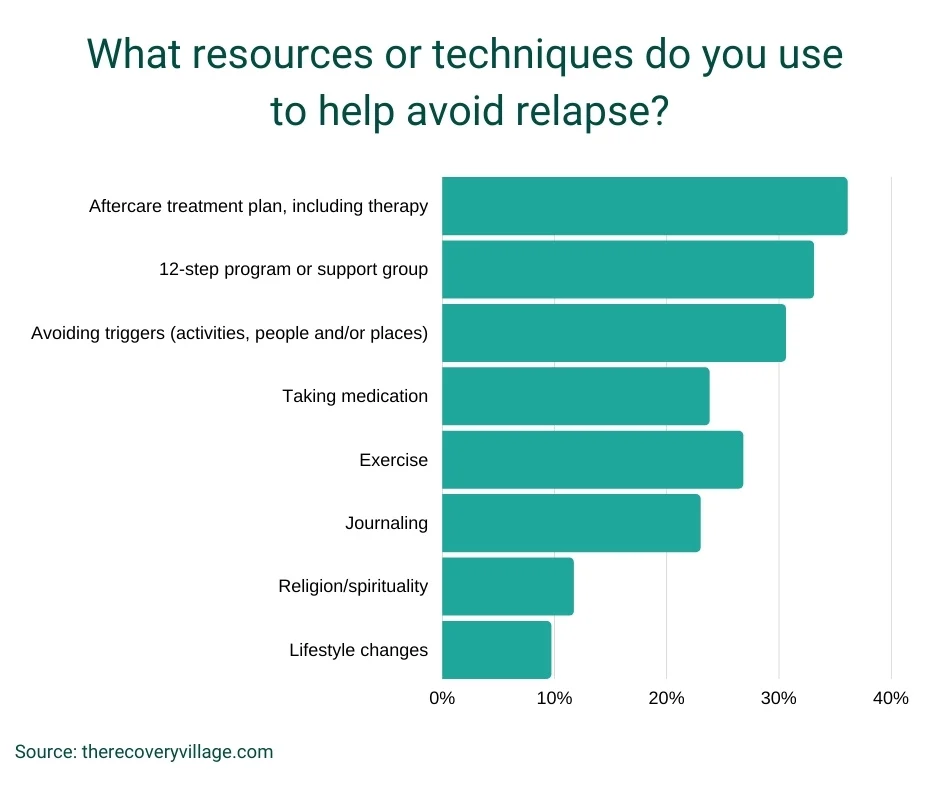
Once you’ve left rehab treatment, many resources and techniques are available to help you avoid relapsing back to meth use. When asked to rank these techniques, respondents considered avoiding triggers, lifestyle changes and exercise their top three techniques. Creating arelapse prevention planinvolving some or all of these techniques is a core part ofaftercareat The Recovery Village.
Discover a Life Without Meth Through Rehab
Deciding to stop using methamphetamine can be a challenging but life-changing step on the path to long-term recovery. As yearly meth overdose deaths continue to climb, this survey data shows the prevalence of heavy use among meth users and how it multiplies your risks for damaging health complications, hospital visits and personal struggles. It also shows what others have experienced during detox, treatment, and recovery, so you can better understand what to expect.
Thousands of people have worked towards a better life without meth through substance abuse treatment. Whether it’s your first time in rehab or not, you or a loved one can join them in recovery.Contact us todayto speak to one of our intake coordinators who will help you understand the programs we offer, how insurance can help cover the costs of rehab and how we’ll support you every step of the way.







